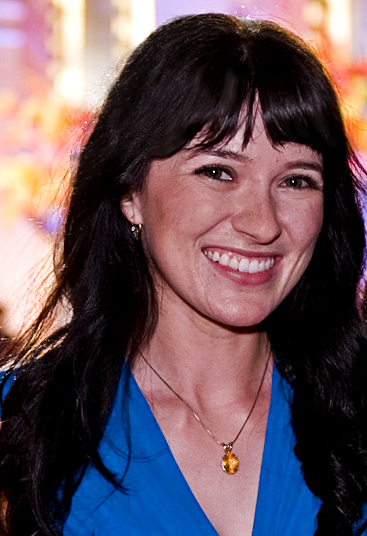Erin Banks (pictured) works in the public relations office at the Church of Scientology. She responded to questions about the intersection of Scientology and the arts.
Menachem Wecker: L. Ron Hubbard is quoted as saying that "art is not just the fodder of a close-knit group of initiates but the soul food of all people." What does that mean that art is the "soul food" of all people?
 Erin Banks: L. Ron Hubbard made this statement in July of 1973 in an issue entitled "Art, More About." This article is contained in the book Art by L. Ron Hubbard. He also wrote extensively about the artist in his book Science of Survival -- specifically, from book two chapter 18, where Mr. Hubbard describes art at length and the role of the artist in society.
Erin Banks: L. Ron Hubbard made this statement in July of 1973 in an issue entitled "Art, More About." This article is contained in the book Art by L. Ron Hubbard. He also wrote extensively about the artist in his book Science of Survival -- specifically, from book two chapter 18, where Mr. Hubbard describes art at length and the role of the artist in society.
In Scientology we believe the artist and his art breathes life into the entire culture. Great art lifts and inspires one to greatness and to achieve things beyond what one previously had thought or imagined, and this is the importance that we rightly grant to art in Scientology.
MW: He also said, "A culture is only as great as its dreams, and its dreams are dreamed by artists." Does that mean that Scientology holds not only that the faith can help artists improve their artistic motivations and visions, but also that art has something to offer to Scientology and a means to shape the faith in unique ways?
EB: Mr. Hubbard was referring to the contributions artists make to society. The above referenced chapter from Science of Survival explains this more fully.
MW: It's clear from navigating the Scientology website that there aren't a lot of works of fine art (as opposed to photos or videos), as there are on, say, the LDS website. Is that because art is not a huge priority in Scientology, or are there not a lot of artists who are Scientologists?
EB: No, it is simply because the website is not a showcase for works of art by individual Scientologists. Scientology has an entire network of churches that are dedicated to all types of artists and enhancing their ability to create art. These are called Celebrity Centres.
Also the Church of Scientology International has its own audio/visual production facilities in California -- Golden Era Productions. The artists at Gold express their art through their acting, stage and set design, costumes, makeup and the myriad art forms involved in film and audio production. They are top of the line artists, as you can see from the videos on the Church's website and the films they produce. We also have a video featuring them on the website, which you find here.
Another example of the priority of art would be the unique handcrafted murals created by Scientologists and featured in every one of our 22 new Ideal Churches that have opened around the world in cities such as Rome, London and New York. Of course the artistic skill and aesthetic result of the artistry exhibited in the creation of our websites themselves should not be ignored.
As members of a new religion, to what extent have Scientologist artists mined already existent religious artistic traditions, and to what extent do they see themselves as heirs to a longer aesthetic tradition, as opposed to pioneers of a wholly new type of art?
EB: This is more appropriately a question for a Scientologist who is an artist rather than something to be asked of the Church.
MW: Who are some of the most important Scientologist artists working today?
EB: There are so many fine painters, sculptors, musicians, actors, dancers, photographers, cinematographers and other artists who are Scientologists, I could not begin to name them without omitting important names. You can see some of them in the "Meet a Scientologist" section of the Church's website.
MW: What are a few of the biggest misperceptions non-Scientologists have about the religion? To what extent do you think artists could help correct those errors through their art?
EB: Like any new religion, Scientology is subject to misconceptions when people know little or nothing about it. Our websites strive to educate people on Scientology and our beliefs. Education is the greatest remedy for the intolerance or discrimination that invariably attends lack of knowledge or lack of effort to discover for oneself what Scientology is.
We get a lot of questions about who we are, what we do, what we believe, and art and communication through aesthetics play an important part in filling the vacuum by educating people about Scientology. As early as the 1960s, L. Ron Hubbard saw the value of film as a medium to communicate concepts in Scientology that are best communicated visually. As you can see from the Church's websites, the artists who work at the Church's Golden Era Productions are using their art to communicate spiritual concepts in Scientology to people in very innovative ways.
MW: There seems to be a lot of visual components to the Time Track. Is there religious fodder for Scientologist artists in this aspect of Dianetics?
EB: Certainly people use their time track (the very accurate recording of a person's past in consecutive record as mental image pictures) or if you will, their memories, as fodder all the time for their works of art. This is reflected in the incredible artistic and ground breaking work which went into creating the four and half hours of the How to Use Dianetics now available on DVD.